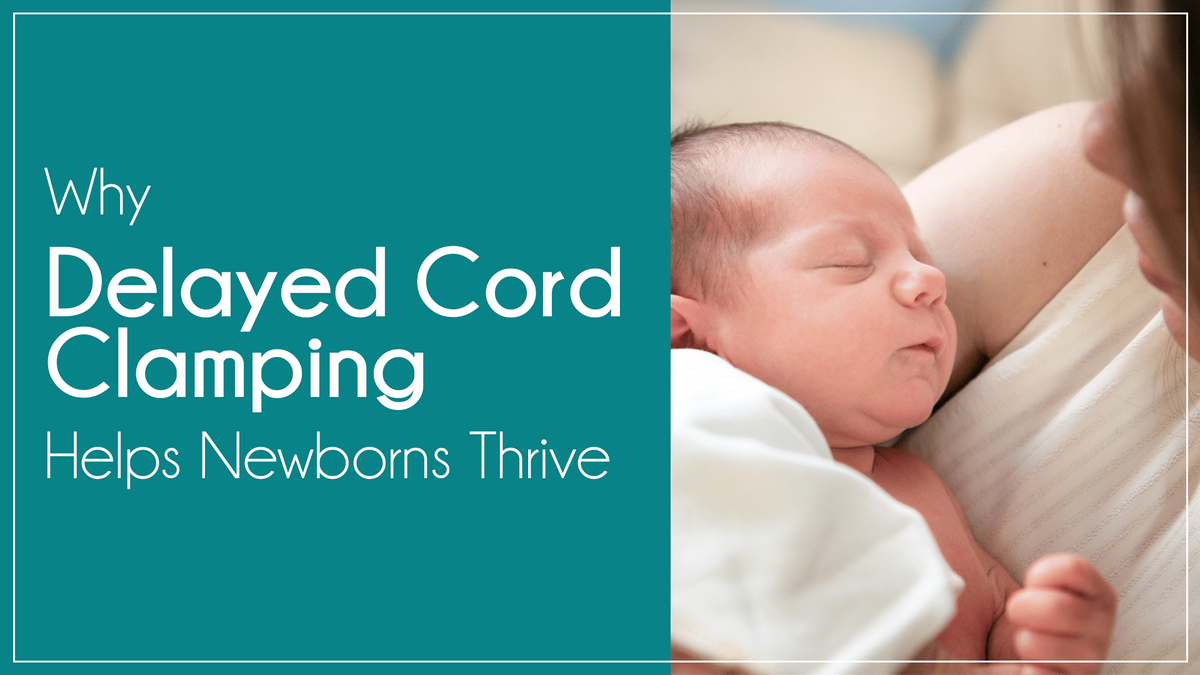Why Delayed Cord Clamping Helps Newborns Thrive

Have you ever noticed how everyone seems to have an opinion on what you should do, especially when you’re preparing for birth? As a mama, you’re already carrying so much, physically and emotionally, and the last thing you need is pressure to rush through decisions that deserve space and intention.
In the middle of all the planning and advice, it’s easy to overlook the quieter moments that can have a lasting impact. One of those moments is what happens right after your baby is born, when the cord that connects you, both is still pulsing with life.
That cord has been your baby’s lifeline for months, delivering oxygen, nutrients, and connection. Allowing a little more time to finish that job can give your baby extra support as they adjust to the world around them.
In this article, we’ll take a closer look at what delayed cord clamping really means and how this simple, mindful choice can help your baby begin life feeling steady, supported, and strong.

What Is Delayed Cord Clamping?
When your baby is born, the umbilical cord is still actively supporting their body as they begin breathing and adjusting outside the womb. Delayed cord clamping honors this transition by allowing a little more time before cutting the cord.
Definition and Basic Process
Delayed cord clamping means waiting between 30 seconds and 5 minutes after birth before clamping and cutting the umbilical cord. During this time, blood continues to flow from the placenta to your baby. This gentle, natural transfer offers a range of health benefits during your baby’s first minutes of life.
Historical vs. Modern Practices
Immediate cord clamping was once a standard routine. Over time, research and experience have shown that giving the cord time to finish pulsing can better support newborns as they transition to life outside the womb. Today, more care providers and birth professionals recognize the value of waiting before clamping.

10 Benefits of Delayed Cord Clamping for Newborns
The extra time may be brief, but the benefits can be meaningful. Delayed cord clamping supports both physical and developmental health in ways that can extend far beyond the delivery room.
1. Increased Blood Volume
Waiting before clamping the cord allows up to one-third more of your baby’s blood volume to transfer from the placenta. This extra volume supports better circulation in the first few hours of life.
2. Higher Iron Stores
Babies receive more iron-rich red blood cells through delayed clamping. This added iron helps prevent anemia and supports healthy growth and development during infancy.
3. Improved Oxygen During Birth
The red blood cells passing through the cord also carry oxygen. This helps organs function well during those critical early moments outside the womb.
4. Better Cardiovascular Transition
Delaying the clamp helps regulate your baby’s heart rate and blood pressure. It creates a smoother adjustment from receiving oxygen through the placenta to independent circulation.
5. Enhanced Respiratory Function
Allowing the cord to continue providing oxygen while your baby begins to breathe on their own can reduce early breathing difficulties and support a steadier start.
6. Stem Cell Transfer for Healing and Development
Cord blood contains valuable stem cells that support immune function, tissue repair, and long-term development. Delayed clamping allows more of those cells to reach your baby.
7. Stronger Immune Support
Along with stem cells, cord blood contains white blood cells and immunoglobulins. These help build your baby’s immune system and may protect against early infections.
8. Improved Thermoregulation
Increased blood volume also helps babies maintain their body temperature more effectively. This reduces the chance of cold stress shortly after birth.
9. Support for Brain Development
Iron is critical for early brain growth. Babies who receive more iron through delayed clamping may benefit from stronger cognitive and motor development as they grow.
10. Positive Impact on Bonding and Breastfeeding
Delaying the clamp gives you uninterrupted skin-to-skin time. This encourages bonding, supports your baby's emotional adjustment, and may help with establishing breastfeeding.
Common Questions and Considerations
As with many birth-related decisions, you may have a few questions. Here’s what to consider as you think through how delayed cord clamping might fit into your birth preferences.
Is It Safe for All Births?
Delayed cord clamping is considered safe for both vaginal and cesarean births. In rare cases, such as when complications are present, immediate clamping may be necessary.
What About Cord Blood Banking?
If you are planning to bank your baby's cord blood, it's important to know that delaying the clamp may reduce how much blood can be collected. Some families choose to prioritize immediate health benefits, while others work with their provider to find a balance.
.png)
How Parents Can Include It in Their Birth Plan
Delayed cord clamping is a simple request, but one that is worth bringing up early in your planning process.
Talk to Your Provider Ahead of Time
Ask how cord clamping is typically handled and what options are available. Including this preference in your written birth plan helps ensure everyone is on the same page.
Include It in Your Doula Conversations
Your doula can advocate for your wishes during birth. Timing may be adjusted based on how your baby is doing, but in most cases, your team can help make this a part of your experience.
Thrive from the Start with Stork Helpers
Welcoming your baby is a powerful and personal experience. Delayed cord clamping is a gentle pause that brings lasting benefits, giving your baby a strong start supported by the natural design of your body.
If you have questions or want help including this in your birth plan, we’re here for you. Stork Helpers is proud to walk alongside mamas who want to make thoughtful, informed decisions for themselves and their babies.
Contact Stork Helpers to learn more about birth planning or to ask a question.
Already had your baby with Stork Helpers by your side? We’d love to hear your story—leave a five-star review.
Stay connected with us on Facebook, Instagram, and LinkedIn for more insight, encouragement, and trusted guidance.

